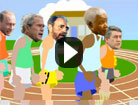I’ve been learning what works and what doesn’t in new-style Communities of Practice, using Facebook-type tools where the members write the content. More precisely, the content kind of falls out of conversations they have with each other. They ask each other questions, compare their practices, and hundreds of other community members feed off the answers.
These ‘feeders’ are commonly called ‘lurkers’, which is as disparaging as well, er, ‘feeders’, I suppose, so I have to stop using ‘feeders’ and think of….’learners’, There. That’s better.
The most effective form of learning is in fact teaching what we think we know and then learning from people who are the formal learners – adapting our thoughts with the help of their feedback – or who are our peers…in fact, anyone.
But, most ‘learners’ think of it as a passive Hoovering up process. Conversations generate insights and share practices, but the outcome isn’t knowable in advance: it emerges.
Anyway, I digress. I thought my role with the community of practice I have built, www.TheLeadershipHub.com , was to pump prime it, bring people together, throw in some themes, then get out of the way to see what emerges from their conversations.
The danger of blog-type communities (and the underlying technology is basically blog technology) is that they can revolve too much around one person. I wanted to keep out of the way where possible and let weak ties between other members grow into strong ties (some of them) rather than me being the Hub of a network…which isn’t scalable, sustainable or even desirable in this context. (I’m not criticising bloggers here. This is different, in a community context).
My role has turned out to be a kind of party host, which I enjoy: spotting people who have common interests and putting them in touch with each other, helping a member broadcast a problem or question to the rest of the community and then channeling answers and solutions back to them.
It’s a bit like sitting people next to each other at dinner whom you know will get on and then watching their faces light up as they discover common interests and passions: it’s a delight.
But then what to do with the often fascinating (sometimes not so) content that comes out of their conversations. I was listening to a curator at the Natural History Museum today and it suddenly occurred to me, this is as important a part of the role (the role of a community administrator, I mean) as introducing people and helping people get used to sometimes clunky Web 2.0 tools (‘community literacy’), and occasionally coaxing people to find their voice (encouraging people with brilliant things to say, who say them to me, to say them to the rest of the community).
And now I know that (as I spotted over at Ted, I think, where they and other community sites spotted this before me) there is a Curator role here: grouping together interesting content that is generated by conversations between members, ‘archiving’ it to some extent (but not in a dusty room, just in easy-access, easy-label areas where it becomes a useful and constantly referred to store of knowledge and ideas and practice).
It’s ‘sensemaking’ I suppose. So, I have a role beyond party host. Editing, sensemaking, labelling, spotting patterns and connections and then highlighting the bigger themes that bring the different content together.
This I like: Curators are behind the scenes people – like stage managers or something – that create the stage on which the creative stuff is played out, with an added light Directorial role in teasing out the theme and making it explicit and entertaining.
Anyway, just needed to get that down: I’m a Curator. All community hosts in these new-style communities of practice have a curator role that can help the sense of the community to emerge, Wisdom of Crowds-style. I like it.









Leave a Reply